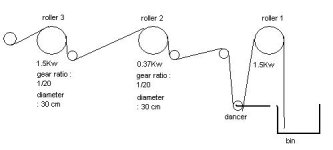Consider a textile machine with a first roll pulling material from a supply box. After this first roll there is a dancer roll, that the first roll uses to regulate its speed (dancer roll has to be constantly in middle position). After that there is a second roll pulling the material, and after the second roll there is a third roll also pulling the material.
Consider the third roll being master, and operates at a fixed speed and maximum torque is allowd (160% of nominal torque). The second roll pulls from the first roll and also has to create tension between itself and the third roll. To create tension the speed is set 10% slower then the third roll and the tension is regulated by reducing its maximum torque.
Because the master (third roll) has more force then the second roll, the second roll will take up the same speed as the third roll (it will be pulled). I suppose the pull resistance of the second roll will be regulated by the 'regenerative torque'.
If for instance the force the balancer roll puts on the textile between the first and seoond rol is 1000N, the 'regenerative torque' of the second roll is 500N and the 'motoring torque' of the second roll is 3000N, how much will be the torque that the third roll has to pull?
I am a bit confused if the second roll will be a help for the third roll in pulling from the dancer roll because it has to pull the second roll to its own speed, will the second roll deliver all the pulling force for the dancing roll, or will that force be delivered by the third roll exclusively?
Consider the third roll being master, and operates at a fixed speed and maximum torque is allowd (160% of nominal torque). The second roll pulls from the first roll and also has to create tension between itself and the third roll. To create tension the speed is set 10% slower then the third roll and the tension is regulated by reducing its maximum torque.
Because the master (third roll) has more force then the second roll, the second roll will take up the same speed as the third roll (it will be pulled). I suppose the pull resistance of the second roll will be regulated by the 'regenerative torque'.
If for instance the force the balancer roll puts on the textile between the first and seoond rol is 1000N, the 'regenerative torque' of the second roll is 500N and the 'motoring torque' of the second roll is 3000N, how much will be the torque that the third roll has to pull?
I am a bit confused if the second roll will be a help for the third roll in pulling from the dancer roll because it has to pull the second roll to its own speed, will the second roll deliver all the pulling force for the dancing roll, or will that force be delivered by the third roll exclusively?





